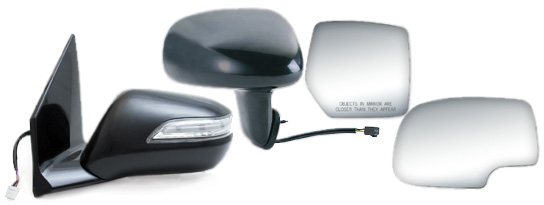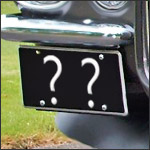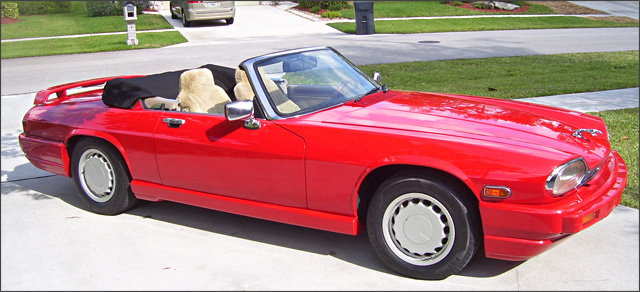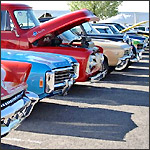|
|
Great service! I'm in New Zealand (on the other side of the world from these guys) and the parts turned up when they said they would. It was a quick and easy process.
Hayden in New Zealand
|
Upcoming Events
If you would like your event featured here e-mail with details. |
|
|
5th Annual Wildgame Cook-Off
2/1/2015
Denison, TX
e-mail
13th Annual Snow-Buster Automotive Swap Meet & Car Show
2/1/2015
Hamburg NY
e-mail
Kalamazoo Antique Auto Restorers Club 52nd Annual Swap Meet & Car Show
2/7/2015
Kalamazoo, MI
e-mail
Boggy Bottom Auto Fest
2/7/2015
Plant City, FL
e-mail
Annual Cars for the Cure
2/7/2015
Orlando, FL
e-mail
10th Annual Bayou Bash
2/7/2015
Kansas City, KS
e-mail
Motoring Thru Time
2/7/2015
Pheonix, AZ
e-mail
Hot Rods & Hatters 4th Annual Car Show
2/7/2015
Lockhart, TX
e-mail
Valentines Day Fundraiser
2/14/2015
Brockport, NY
e-mail
Burnyzz Day of Fire Car Show & Dyno Day
2/14/2015
Ocala, FL
e-mail
|
|
K Source Mirrors |
|
RockAuto now offers K Source mirrors and mirror glass. K Source has been making OE and replacement mirrors for more than 60 years. Their diverse product line, which includes car mirrors, truck mirrors, replacement glass, and towing mirrors, is manufactured under strict quality guidelines at five factories worldwide. All direct replacement mirrors are guaranteed to fit and function like the originals. RockAuto has K Source mirrors and replacement glass at reliably low prices for a wide variety of vehicles ranging from Acura, to Jeep, to Volkswagen.

 RockAuto is now offering a special promotion on K Source's Snap & Zap towing mirrors RockAuto is now offering a special promotion on K Source's Snap & Zap towing mirrors
Have you been looking for an affordable and easy-to-install mirror to improve rear visibility while towing and backing your trailer? K Source Mirror Extensions are an economical way to reduce blind spots and improve safety while towing. Installation is literally a snap! Snap & Zap mirrors were designed for your Ford, Dodge, GM and Toyota Trucks and SUVs. The final look is truly professional.
Receive an instant 10% rebate in the RockAuto shopping cart on any Snap & Zap towing mirrors through February 19th. You can find the Snap & Zap "Outside Mirror Extenders" under the "Accessories" category for specific vehicles in the RockAuto catalog.
(Traditional universal fit towing mirrors that clamp or strap on any truck mirror are found in the "Body" category under the "Tools & Universal Parts" catalog tab.) |

Rostra Back Up Cameras |
|
Back up cameras are becoming standard equipment on new cars and trucks. Now, on almost any older vehicle, you can expand the view out the back window and reduce dangerous blind spots near the rear bumper by installing your own back up camera system. RockAuto now carries RearSight back up camera systems by Rostra! Rostra makes direct-fit tailgate handle cameras for GM Silverados/Sierras, Ford F-Series, Toyota Tacomas and Dodge Rams.
Rostra's universal-fit systems make installation on other vehicles as simple as installing a new rear-view mirror (with built in LCD monitor) and a new license plate bracket (with built in camera).
You can find direct-fit camera systems under the "Accessories" category for specific vehicles in the catalog. Universal-fit back up camera systems are found in the RockAuto catalog's "Tools & Universal Parts" tab, and also under the "Accessories" category.
|

Forum of the Month |
|
FordF150.net is more than just a forum for Ford truck owners and enthusiasts. The site is a great resource for technical articles, specifications, photo galleries and more dedicated to the F-150 and other Ford trucks. FordF150.net is one of the largest Ford truck enthusiast web sites and is celebrating 15 years of operation in 2015. We’re proud to have 140,000+ members and 44,000+ photos. Stop by the site and register in the forum today to interact with fellow Ford truck enthusiasts.
If you are the
administrator or member of a forum
and you would like to see your website
featured in an upcoming newsletter
and receive a discount code to share
with your members, contact marketing@rockauto.com. |

Repair
Mistakes & Blunders |
|
I had a 1977 MGB that would randomly overheat. I could be in traffic or going down the highway on a 70 degree day. Regardless of the conditions, I would look down at the temperature gauge, and chances were good that it would be in the red! I flushed out the radiator and cooling system and put in a fluid that was supposed to transfer heat better - all to no avail.
Driving down the highway one 60 degree night, the temperature gauge showed the engine overheating again. I started thinking this was improbable. I reached up under the dash and wiggled some wires - the temperature went right back to normal. British electronics at it again!? After a bit of troubleshooting, I finally found that the dash voltage regulator had a bad ground that was causing the errant temperature gauge readings.
Sheldon in Massachusetts
Tell us about
your most infamous auto repair blunder
or unconventional fix. Use your woe
to help others avoid similar mistakes
or share off-the-wall solutions that
worked (at least for a while!). Please
e-mail your story to flamur@rockauto.com.
Include your mailing address and if
you would like a RockAuto T-Shirt
(please let us know your shirt size)
or Hat if we publish your story. See
the T-Shirts and Hats under Tools
& Universal Parts in the catalog.
The story will be credited using only
your first name and your vague geographic
location (state, province, country,
continent, etc.) so you can remain
semi-anonymous! |

Automotive Trivia |

|
What is the difference between a wet sump and a dry sump oil system?
A. Four-stroke engines are wet sump because they have an oil system plumbed separately from the fuel system. Two-stroke engines are dry sump because the oil is mixed with the gasoline.
B. A wet sump engine collects oil in and pumps oil from an oil pan located below the crankcase. A dry sump system uses a separate oil reservoir and pump(s) connected to the engine/crankcase via plumbing.
C. A wet sump system uses an oil pump submerged in the oil pan to circulate oil. A dry sump system does not have an oil pump. The crankshaft is submerged in the oil pan and its motion generates the pressure necessary to circulate the oil through the engine.
Answer
below |

I Just Thought Cooler Was Always Better |

|
With every repair, I always hoped to eke more horsepower out of my first car, a very rusty 1977 Dodge Monaco. After all, it was a V8 powered two-door B-body like the Duke boys' 1969 Dodge Charger, the “General Lee.” My feverish 16-year-old brain dreamed that buried deep inside my pokey, low-compression engine was a legendary ‘60s muscle car motor waiting to be freed.
Some of my performance upgrades, such as using premium spark plug wires, rotor and distributor cap (RockAuto now offers these in a complete “Tune-Up Kit”), did not add 100 hp, but certainly made the engine easier to start and run better. Other upgrades turned out to not be upgrades at all. There was the water injection system that mostly just made the choke rusty. There was the fuel line pressure enhancer that never lived up to its promises of phenomenal gas mileage. For this article, I want to discuss my ill-conceived “upgrade” to a lower temperature thermostat.
The Dodge’s engine did not overheat or have other cooling system problems. I just thought cooler was always better. Although Chrysler, the OEM, had specified a 195 F (91 C) thermostat, I wanted a cooler, 160 F (71 C) thermostat. After all, high performance engines need additional cooling and my engine was going to be high performance someday. If RockAuto.com had been around in the ‘80s, then I might have reconsidered my thermostat choice after using the catalog to quickly discover that 195 F was the OEM temperature for the General Lee too!
Thermostats open when a special wax inside melts and expands. A 160 F thermostat begins to open and release large volumes of coolant to the radiator when the coolant reaches 160 F. The thermostat will be fully open once the coolant gets another ten or fifteen degrees warmer.

Typical Thermostat
The 160 F thermostat did not really make my engine run cooler. Releasing coolant earlier into the radiator only made my engine slower to warm up to its proper operating temperature of 195+ degrees. Doubling the engine’s warm-up time from ten minutes to twenty minutes had no benefits. Longer warm ups just meant more time enduring a carbureted engine that was more likely to hesitate, stall, idle too fast and/or waste gas.
Many of my trips were five miles or less. Short trips meant the engine was even less likely to get up to the right operating temperature. Water condensed in the engine oil might never steam off. I bet the General Lee never made the Duke boys shiver while they waited in vain for the coolant to heat up so the heater could start working!
The OEM temperature thermostat is the right choice for most engines, but it can make sense using a lower, alternate temperature thermostat in specific situations. Maybe an old vehicle with a partially clogged radiator or other cooling system problems can make it the five miles up the steep hill without overheating if the engine takes a little longer to heat up. Maybe a different thermostat temperature is called for if the engine has been modified and/or the thermostat has been relocated.
Using a lower temperature thermostat can cause even more trouble for a modern engine with numerous computers that use the coolant temperature to help control the fuel, emissions and other important systems. Some of the newest engines have multiple thermostats. There is nothing high-performance about confused computers and unnecessarily turning on the Check Engine light.
A worn out thermostat might also be opening before the OEM specified temperature or be permanently stuck open. It is a good idea to replace the thermostat when the coolant and/or radiator hoses are changed.
Despite mind-boggling rust, my experimenting and the occasional dubious upgrade, that Dodge still served me through college and even after I started working at Chrysler as a brand new engineer!
Tom Taylor,
RockAuto.com
To read more of Tom's articles, click this link and choose from story titles on the Newsletter Archives page. |

| Jim's 1988 Jaguar XJS |
 |
I found this 1988 Jaguar XJS V12 Convertible that had been sitting under a tarp in a warehouse for 12 years. The seller purchased it from a New England Patriot football player who had never put it on the road. It had 44k miles on it and every option imaginable (built in phone, CD changer, security system and radar detector) for the day.
The car is one of the earliest factory convertibles made (manufacture date of 10/87). The official release of the convertibles was for the 1989 model year. So this is a pre-release model with the Tom Wilkenshaw Racing (TWR) package on it. I do not have the original window sticker, but I'm sure the asking price was outrageous for 1988.
Thank you RockAuto for the honestly priced parts! You help me keep this (and all my other cars) on the road.
Jim in New York |
Share Your
Hard Work |
Do you purchase parts from RockAuto? If so, RockAuto would like to give you the opportunity to have your car or truck possibly featured in one (or occasionally more) of our publications such as the monthly newsletter, collector magnets or RockAuto social media.
New, old, import, domestic,
daily driver, trailer queen,
classic, antique, we want to
see them all! Please e-mail flamur@rockauto.com with your vehicle's history,
interesting details, your favorite
images and what parts from
RockAuto you have used.
|
Let
RockAuto Help |

|
Are
you organizing a car show or
other auto related event? From
goody bag stuffers to gift certificates...RockAuto
can help. We can even publicize
your event in our newsletter.
Just
send an e-mail to marketing@rockauto.com with information about your
show.
|

Automotive
Trivia Answer |

|
What is the difference between a wet sump and a dry sump oil system?
A. Four-stroke engines are wet sump because they have an oil system plumbed separately from the fuel system. Two-stroke engines are dry sump because the oil is mixed with the gasoline.
Answer: B. A wet sump engine collects oil in and pumps oil from an oil pan located below the crankcase. A dry sump system uses a separate oil reservoir and pump(s) connected to the engine/crankcase via plumbing. (Most engines are wet sump. Dry sump's advantages include lowering engine height, increasing oil capacity and better maintaining oil pressure during high speed turns. Two primary disadvantages are dry sump's higher cost and complexity.)
C. A wet sump system uses an oil pump submerged in the oil pan to circulate oil. A dry sump system does not have an oil pump. The crankshaft is submerged in the oil pan and its motion generates the pressure necessary to circulate the oil through the engine.
Back up to trivia question |
© 1999-2015 RockAuto, LLC - Madison, Wisconsin USA. RockAuto name, logo and ALL THE PARTS YOUR CAR WILL EVER NEED are registered trademarks of RockAuto, LLC. Manufacturer names and logos in the RockAuto catalog are trademarks of their respective companies and are used only to identify their products. All rights reserved. |
|
|
|
|